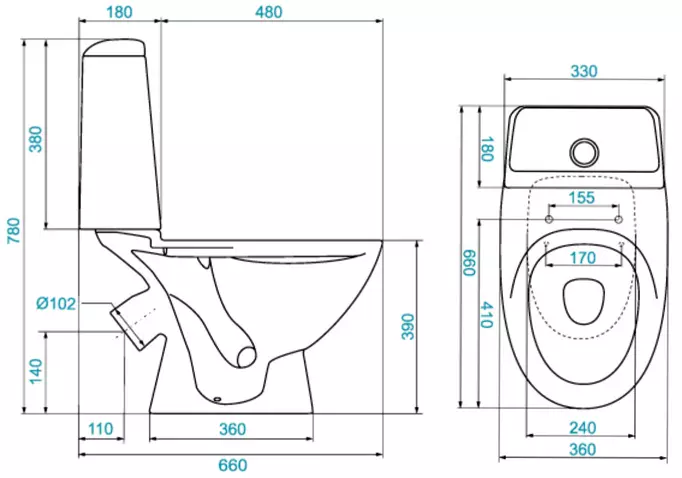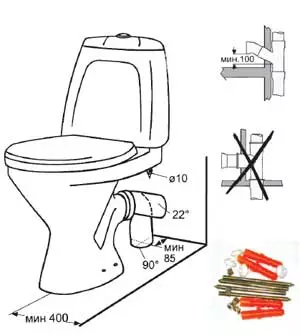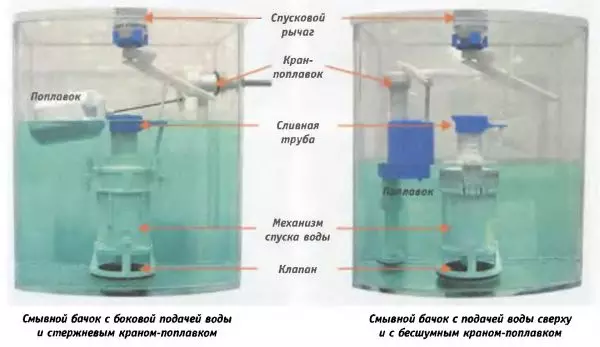The design of the toilet should be simultaneously convenient (to approach all family members for growth) and easily read.

COMPACT SCONE UNITAZ Size.
The convenience of operating the toilet and all its constituents depends on the type of construction: a flushing complex, bowl forms and other things.
Each of these parameters will be described in most detailed further.
In the midst of the structures of the toilet, it is possible to distinguish the following features:
- The mechanism of the drain tank toilet bowl;
- Complex of flush toilet;
- release device;
- Registration of bowls of toilet bowl.
Plum Tank Mechanism in Toilet Design: General Information
The structure of the structure and connection of the toilet bowl.The functioning of the buck of the toilet toilet depends on the shut-off reinforcement, which is located inside it. A variety of types of design of this element in a drain tank are largely affected by the features of the work of the toilet.
The mechanism of a drain tank toilet contains 2 main valves:
- Responsible for the set of water into the drain tank (the set of water set in the drain tank).
- Responsible for the descent of water directly in the toilet (drain unit of the toilet).
Armature, which is responsible for a set of water in the tank, can be 2 types:
- For a set of water in the top of the tank. This method of placing shut-off valves can be found in the cheapest toilet bowls of the domestic sample. This option of filling the tank creates a decent amount of noise.
- Armature that dials water into the lower area of the tank for a drain in the toilet. This tank filling complex can be found in the block of toilet bowls of both imported and domestic manufacturers. This placement of shut-off valves creates much less noise.
Materials for the creation of toilet
Today, the toileties are created from a variety of materials: in addition to standard porcelain and faience types, steel, plastic, glass, cast-iron, and even golden . The main variations of sanitary ceramics are presented in the form of porcelain and faience, which are manufactured on the basis of the same raw materials. The main difference between them is the ratio of different raw materials and processing technologies, which leads to a variety of physical qualities of manufactured materials.
Foyans familiar to many, because it was often released during the USSR. The minuses of this material should include a large percentage of porosity and significant water absorption (in the region of 9-12%). In view of this substance, the tinsel is usually covered above, which does not simply perform a decorative function, but also provides the walls of the shell protection against aggressive cleaning solutions. As a result, more efficient cleaning during washed. The duration of the operation of units made on the basis of faience is approximately 30 years.
Porcelain create only the most best clay varieties. Thus, the material is obtained more dense and less porous. Moreover, it practically does not absorb water (0.8%). High-quality products from the porcelain orderly retain the smoothness of the glaze longer, so it is much easier to maintain their purity. It is the porcelain today today give the greatest preference. In the case of sufficiently gentle operation, porcelain products will be able to serve their owners in the area of 50 years.
Designs created using other materials (glass, marble, wood, not to mention semi-precious and precious stones), almost to unrealize in the world market in everyday sale. These things are manufactured specifically to order.
Devices in the toilet: Features of work
Types of toilet bowls.The drain design is activated by pressing the special button or stretching the rod. The latter meets only in low-cost domestic toilets.
Article on the topic: Decoration of ladder laminate with their own hands (photo and video)
The most common mechanism for drain - push-button. This water descent device is the button equipped with a lever, which is located in the construction of the toilet bowl. The button can be placed either on the toilet bowl cover, or on the wall (in the case of a hidden tank design).
The insertion trigger device, which is activated by pressing a special button, may be single and dual-mode types.
The second case implies the descent of absolutely all the water from the tank. The first type of device, in turn, removes only half the tank, thereby allowing to save water.
A two-mode water drain complex can be represented by one button where the number of descended water directly depends on the pressure force on the button.
Wash complexes in the toilet: classification

Diagram for connecting the toilet to sewage.
There are 2 sets of descent in the toilet: a circular (shower) and a horizontal (cascade).
The horizontal descent is a classic water supply system into the bowl of the toilet bowl. At the same time, the water is washes a bowl with a solid flow, but only one side of it.
This system is less expensive, in contrast to a shower wash and stand out among other extensive service life. Among the minuses of the horizontal wash, it is worth highlighting a low percentage of tightness, since the aqueous stream covers not the entire container of the bowl. As a result, it is necessary to clean the toilet to clean the toilet. Among other things, the horizontal type of flushing is in-economically spending water.
The circular flush implies a uniform water supply throughout the perimeter of the structure of the toilet bowl. Moreover, the jet of water can be directed both at an angle to the formation of the toilet and directly.
This device washing the toilet is different against the background of other minimum noise, economical water consumption and wonderful cleansing qualities.
The disadvantage of such units is quite high cost than at similar designs with a horizontal descent. In addition, a small diameter of the holes through which water is supplied increases the risk of deterioration of the quality of the flush. This may happen due to the high degree of water rigidity, which over time clogs the data of the holes. Thus, if water is supplied to the water of increased hardness, you should select either a large diameter of the holes in the toilet with a circular flush complex, or a horizontal type of flush.
Descent toilet bowl
Installation circuit and connecting the drain tank.The descent of the toilet directly depends on the placement of the sewer pipe at home.
The release of the toilet can be divided into 3 main types to be divided into 3 main types:
- Vertical.
- Spit with a slope of 30-45 °.
- Horizontal edition.
The latter can be found in the houses of modern planning (many houses of the postprokery interval).
The sewer complex equipped with the toilet with the vertical release, in most of the first half of the twentieth century (Stalin's houses) in its majority can be found in apartments.
In the houses, the structure of the second half of the twentieth century (Brezhnevka and Khrushchevka) The sewage complex is provided specifically for installation of toilet bowls with an oblique type of release.
Before acquiring the toilet, it is necessary to clarify which release of the sewage pipe is present in the house.
Toilet bowls with oblique and horizontal releases are more versatile structures, since they make it possible to connect the toilet to the sewage risers in any position. To do this, you must purchase specialized transition nozzles. The vertical type of descent allows you to place the toilet tightly to the wall.
Variations of drain tanks toilet bowl
Toilet sequence.
The current classification of tanks for descent is much more diverse than it was 20 years ago. In order not to get lost in such a wide variety, it will not be superfluous to familiarize yourself with a similar plumbing device and its variations.
Article on the topic: Mirror ceiling in the bedroom with their own hands (photo)
According to the type of materials used, the tanks can be:
- Metal (more often - cast-iron) - durable, but external design does not differ in high aesthetics;
- Plastic (plastic) are the easiest among all others, very simple in the installation, but are subject to mechanical damage;
- Ceramic - safe, easy to install, have a huge range of diverse colors and shapes.
By type of mechanism for descent:

Unitaase installation scheme: correct and incorrect.
- Side - represent a chain (rope), equipped with a tank, which, in turn, is located at a low height of the toilet; The principle of operation of the drain device in this case is the following: The rope pulls the lever, and on the reverse shoulder, the box with a gasket is slightly lifted, and water passes into the plum pipe.
- Top - head or button located on top on the lid on the central part; Here, water passes into the pipe for a drain only after pressing the desired button or raising up the rod (stem); At the time of pressing the pear of rubber is raised with the so-called saddle and passes the water flow.
By type of descent device:
- Mechanical - control for everything is carried out without user participation;
- Manual - Valve Barrel opens if the owner is desired; It has the ability to control the volume of the liquid that enters the tank.
Next, you can select the types of drain tanks according to the variations of their installation:
- The tank can be located almost under the flux by connecting to the toilet through the long reinforcement. This option allows you to reach the maximum water pressure during the descent process, however, it looks not even more aesthetic for the current realities of the design.
- The tank is fixed directly on the toilet. The option is quite compact, suitable for a variety of repair work.
- The drain container is built into the structure of the wall. This method makes it possible to free an extra room in the toilet, and it looks very diligently and quite aesthetic. An essential minus, however, is the complexity of work on installation and further repair.
The device of the tank washed in the toilet: how does water go into it?

Diagram of the device of the drain mechanism.
The tank is a container made of metal, ceramics or plastic, which can have varieties of forms and a variety of triggers. The purpose of this device is only one thing - exercise descent and a set of water. This is carried out due to the inner construction of the tank. The mechanism of the flush tank in the toilet is the device, the basis of which is only 2 main components: the mechanism of flushing and the water supply mechanism.
The components of the tank elements also include float, pear, overflow, float valve, levers. These components relating to the design of the device are created from various materials. For example, the float can be made on the basis of plastic or brass, and the pear can be rubber or plastic. Among other things, they may differ in both forms and in the variations of the installation of contacts among themselves. At the same time, the essence of their work remains unchanged.
The water supply device functions using the reinforcement that is responsible for the set of water into the tank.
The water supply complex can be performed by 2 options:
- The reinforcement is located in the upper area of the tank washed, and the water passes through the side canal. At the same time, the float is on the border of the lever, and at the time of their specific level achieve a particular level of this lever produces pressure on the rod. The latter with the help of the membrane closes the flow of water flow. The described method is rather noisy, however, well-widespread in the middle of domestic manufacturers of sanitary devices.
- Armature is located in the lower area of the flush tank (lower feed). The float in this complex performs movement along the vertical stock. The energy to the locking membrane is translated due to the movement of the float using a special thrust, which is a certain regulator limiting the volume of fluid in the tank. This is a relatively more quiet way to set water in comparison with the previous described option.
Article on the topic: Tool for installing chalks and its characteristics
In general, the water supply device into the flush tank is a pretty nomudinal construction that is based on physical laws. However, even the most elementary complexes are not insured against failures and need interference.
The most common breakdowns arising in the swimming device:
- Slow water inflow. This problem is often caused by clogging of the overlap membrane. The solution is simple: it should be cleaned from dust and garbage a hole for water supply. At the same time, the main thing is to carefully disassemble the membrane device, and then consistently collect it together, without leaving any unnecessary parts. From the tools, only standard pliers and nippers should be used.
- Very large amount of water in the tank capacity of the wash. In this case, it is necessary to regulate the water level in the device. The method of solving the problem directly depends on the type of float in the toilet mechanism. When serving, the level is adjustable by unscrewing the lever nut. After that, the lever with a float is lowered slightly lower. At the bottom feed, the float level must be set, rotating the plastic screw craving. Rotation should be done in such a way that the float is lowered. Only when the water level in the tank decreases.
- Floor float levers broke. This malfunction is often not amenable to fix. As a result, it is necessary to replace the entire design of the sweat mechanism of the tank.
Bowl of toilet and her shape
It is very important to correctly decide on the shape of the bowl of the toilet. After all, it depends on this characteristic whether there will be a spray from the toilet in the process of operation.
Varieties of forms of the toilet bowl (3 species):
Tarbed device toilet or toilet with a shelf (this is an outdated mechanism, but if you wish the toilet with the shelf, you can find both import and among domestic models).
Using a plate toilet, splashes will not be observed. However, in the designs of these toilet bowls a lot of minuses. This form of the bowl implies the presence of reinforced smells of life products (the remnants that should be deleted using the shelter are delayed on the shelf. Lowned water, on the shelf there is always a certain amount of water, which causes rusty divorces over time. Moreover, plate-type toilets are very uneconomically consumed by water.
Among the advantages of such structures, it can be noted that they enable additionally follow their own health and health of their loved ones.
Toilet bowl or visor. A bias can be directed both from the front wall and from the back. In both cases, the splashes will be present, and it will sometimes have to use the rash. Nevertheless, the toilet of the visor species guarantees the minimum odors.
Fluorcogous type of toilet bowl. This device is very hygienic, since the rash is needed only sometimes. Moreover, it is quite economical consumed water. However, this design comes with one significant minus - splashes. Many manufacturers are trying to equip the funnel-shaped toilets with the Anten Spex complex, which operates on the principle: the smaller the fluid in the hydrotherapy system (water level in the region of 7 cm), the smaller the splash. Manufacturers of these toilet bowls work on their geometry, seeking the splashes to do not reach a person sitting on the toilet.
Such toilets due to their hygienicness and efficiency are very often equipped in public places (at train stations, in hospitals, in supermarkets, etc.).
